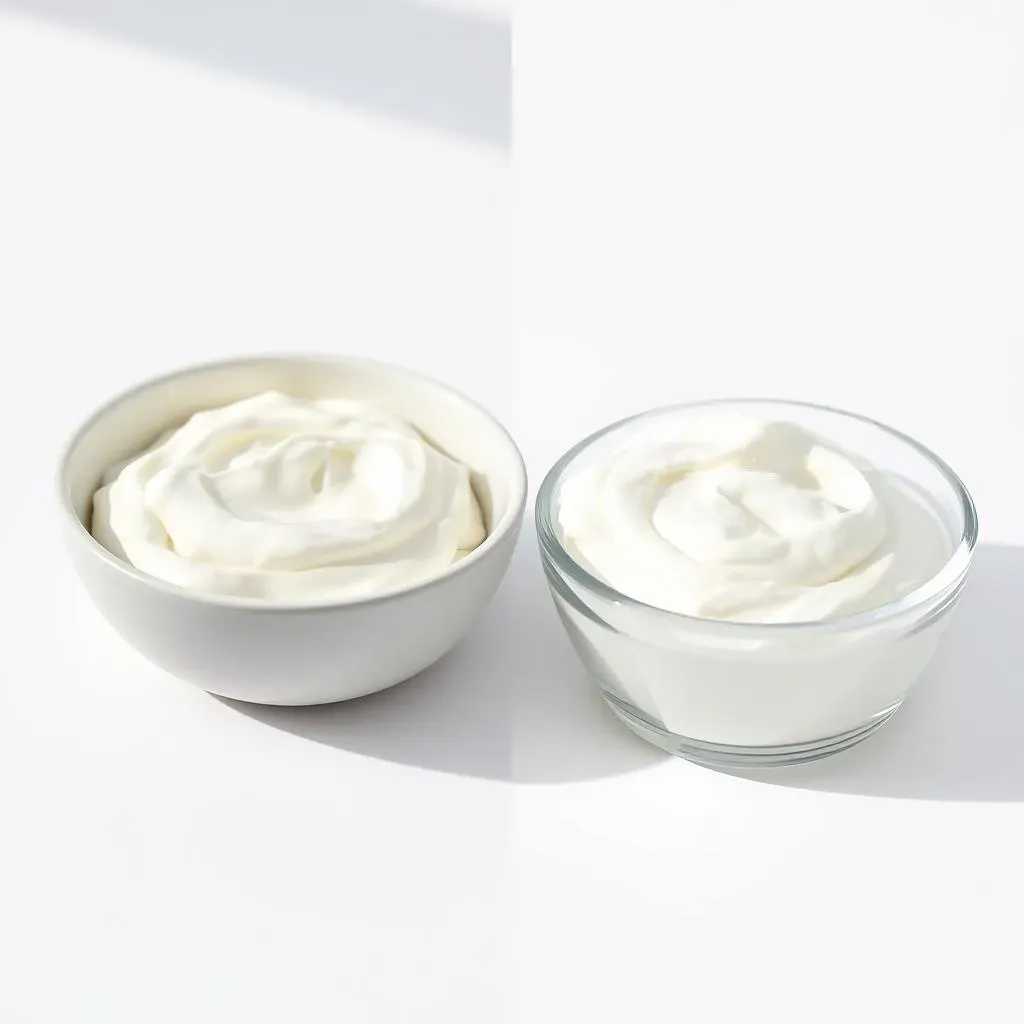Table of Contents
Ever stared blankly at a recipe, realizing you're missing a key ingredient – sour cream? Don't panic! This article explores the burning question: can you substitute Greek yogurt for sour cream? We'll go beyond a simple yes or no, diving deep into the practicalities of this common kitchen swap. We'll examine the nuances of using Greek yogurt as a stand-in for sour cream in both sweet and savory dishes, comparing textures, flavors, and the potential impact on your final creations. From the fluffy perfection of baked goods to the tangy delight of dips and sauces, we'll equip you with the knowledge to make informed decisions. This isn't just about finding a replacement; it's about understanding the subtle differences and achieving the best possible results. We'll cover specific examples and offer practical tips to help you confidently navigate this substitution, ensuring your culinary adventures remain delicious and successful. So, let's unlock the secrets to successfully using Greek yogurt in place of sour cream!
Can You Substitute Greek Yogurt for Sour Cream in Baking?

Can You Substitute Greek Yogurt for Sour Cream in Baking?
So, you're wondering if you can swap Greek yogurt for sour cream in your baking? The short answer is: sometimes! It's not a perfect one-to-one replacement, but it can work surprisingly well in many recipes, especially those that already have a fair amount of moisture. The key is understanding the differences. Sour cream is higher in fat and has a distinctly tangier flavor than even full-fat Greek yogurt. Greek yogurt tends to be a bit more acidic, which can affect the rise of certain baked goods if you're not careful. In cakes and muffins, for example, a direct swap might lead to a slightly denser texture and a less pronounced sour flavor.
Ingredient | Sour Cream | Greek Yogurt |
|---|---|---|
Fat Content | Higher | Lower (even full-fat) |
Acidity | Moderately acidic | More acidic |
Texture | Creamy, smooth | Thicker, potentially slightly grainy |
However, in recipes where the sour cream plays a more subtle role, like some quick breads or cookies, the substitution is often barely noticeable. The higher protein content in Greek yogurt can sometimes create a slightly chewier texture, which might be desirable in certain applications. For instance, I've successfully used Greek yogurt in place of sour cream in many recipes for muffins, and the difference was minimal.
- Try substituting in recipes with other moist ingredients (like bananas or applesauce).
- Start with a smaller amount of Greek yogurt than the recipe calls for sour cream.
- Consider adding a pinch of baking soda to counteract the increased acidity.
Ultimately, the best way to know if a substitution will work is to experiment! Start by making a small batch with the swap and see how it turns out. You might be pleasantly surprised at how versatile Greek yogurt can be in your baking. Remember, baking is a science and an art, and sometimes happy accidents lead to amazing discoveries!
Using Greek Yogurt as a Sour Cream Substitute in Savory Dishes

Using Greek Yogurt as a Sour Cream Substitute in Savory Dishes
Now, let's talk savory! Substituting Greek yogurt for sour cream in savory dishes is often even easier than in baking. The tanginess of Greek yogurt actually complements many savory flavors, adding a bright, fresh note to dips, sauces, and toppings. Think creamy potato toppings, zesty taco fillings, or a cooling dollop on chili. Full-fat Greek yogurt works best here, mimicking sour cream's richness and creaminess. However, remember that Greek yogurt is naturally thinner than sour cream, so you might need to adjust the consistency depending on the recipe. For instance, if you're making a dip, you may want to add a little extra cream cheese or mayonnaise to thicken it up. A little experimentation will go a long way!
- Tacos and burritos: Greek yogurt adds a tangy twist to the usual creamy filling.
- Dips and spreads: Use Greek yogurt as a base for your favorite veggie dip, adding herbs, spices, and other ingredients to taste.
- Soups and stews: A spoonful of Greek yogurt stirred in at the end can add a creamy, tangy richness.
- Potato toppings: Skip the sour cream and use Greek yogurt for a lighter, healthier alternative.
One thing to keep in mind is the salt content. Sour cream often has added salt, while Greek yogurt usually doesn't. You might need to add a pinch of salt to your dish if you're substituting Greek yogurt to balance the flavors. Also, consider the overall texture you're aiming for. If your recipe calls for a very smooth, creamy texture, you might need to blend the Greek yogurt to remove any lumps or grains. A quick whiz in a blender or food processor will do the trick!
Dish | Sour Cream Use | Greek Yogurt Adaptation |
|---|---|---|
Chili | Topping for creaminess | Stir in at the end for tangy creaminess; may need to thin slightly |
Tacos | Creamy base for filling | Adds tangy creaminess; may need to add a little extra moisture (like a bit of milk or water) |
Potato Salad | Adds richness and creaminess | Adds a lighter, tangier creaminess; consider adding a touch of mayo for extra richness |
Don't be afraid to get creative! Greek yogurt's mild tang and creamy texture make it a surprisingly versatile ingredient in savory dishes. Experiment with different flavors and textures to find what works best for you. The possibilities are endless. And remember, cooking should be fun!
Understanding the Differences: Greek Yogurt vs. Sour Cream for the Best Results

Understanding the Differences: Greek Yogurt vs. Sour Cream for the Best Results
Fat Content and Texture: The Creamy Conundrum
Let's face it, the biggest difference between Greek yogurt and sour cream boils down to fat content and the resulting texture. Sour cream is significantly higher in fat, leading to that luscious, smooth, and almost velvety texture we all know and love. Greek yogurt, even the full-fat variety, is naturally lower in fat. This often results in a thicker, sometimes slightly grainy texture. While this can be a plus in certain applications (like a topping for chili where a bit of texture adds interest), it's crucial to remember this difference when making substitutions. In recipes requiring a completely smooth consistency, like a classic cheesecake filling, the lower fat content of Greek yogurt might require adjustments – perhaps a touch of cream cheese or melted butter to achieve that desired creaminess.
Characteristic | Sour Cream | Full-Fat Greek Yogurt |
|---|---|---|
Fat Content | High (around 20%) | Lower (around 10%) |
Texture | Smooth, creamy | Thicker, potentially slightly grainy |
Consistency | Fluid | Thicker |
Acidity and Flavor: A Tangy Tale
Beyond texture, the acidity and resulting flavor profiles of Greek yogurt and sour cream differ subtly but significantly. Sour cream boasts a pleasant, mild tang, while Greek yogurt often possesses a sharper, more pronounced acidity. This can dramatically impact the final taste of your dish. In baking, this increased acidity in Greek yogurt might react differently with leavening agents, potentially altering the rise and overall texture of your baked goods. In savory dishes, the sharper tang of Greek yogurt can be a welcome addition to certain recipes, adding a bright, refreshing counterpoint to rich or heavy flavors. However, in dishes where a milder tang is desired, you might find the Greek yogurt's acidity to be overpowering. In those situations, you could neutralize the acidity by adding a pinch of baking soda to baked goods or a touch of sugar to savory dishes.
- Consider the overall flavor profile of your recipe.
- Adjust for acidity by adding baking soda (baking) or sugar (savory).
- Taste test frequently to ensure the flavor balance is correct.
Making the Right Choice: Context is Key
Ultimately, the decision of whether or not to substitute Greek yogurt for sour cream hinges on understanding the specific needs of your recipe. There's no one-size-fits-all answer; it’s all about context. Consider the role of the sour cream in the recipe. Is it a primary flavor component, contributing significantly to the overall taste and texture? Or does it serve a more subtle role, primarily adding moisture or creaminess? If the sour cream is integral to the dish's flavor profile, a direct swap might be problematic. However, in recipes where the sour cream plays a less prominent role, the substitution is often seamless and even adds a unique twist. The key is to experiment, to understand the subtle differences, and to adjust accordingly. Don’t be afraid to get creative and see what delicious results you can achieve!